✓ Joining us on our Whatsapp Channel: 💬 Explore and Escape!.
Booking through us:
✓ 🏩 🛌 Handpicked Luxury Stays in Budget: Booking.com | Agoda.com
✓ 🍹⛱️ Deals on Private xfers, SIM Cards, City tours, Day trips : 📍🗺️ GetYourGuide | 🛵🧳 Klook
com/landmarks/oceania-landmarks/landmarks-of-australia/”>landmarks in Europe, and so are in India.
India, like an intricately woven tapestry, is a land of countless colors, cultures, and customs.
With each twist and turn, this tapestry reveals an array of magnificent landmarks that hold the nation’s rich heritage.
Each land-form like a precious jewel shines with an aura that reminds us of India’s bygone days and its beautiful present.
1. Taj Mahal – Agra

The Taj Mahal is a mausoleum made of white marble situated in Agra, India. Built in the 17th century, it is considered a symbol of love.
What to see or do: Marvel at the intricate details of the white marble façade adorned with semi-precious stones. Take in the serene beauty of the reflecting pool and surrounding gardens.
Don’t miss: Don’t miss seeing the Taj Mahal at sunrise or sunset when the changing light provides a breathtaking view.
Insider travel tips: Arrive early in the morning to beat the crowds.
2. Qutub Minar – Delhi
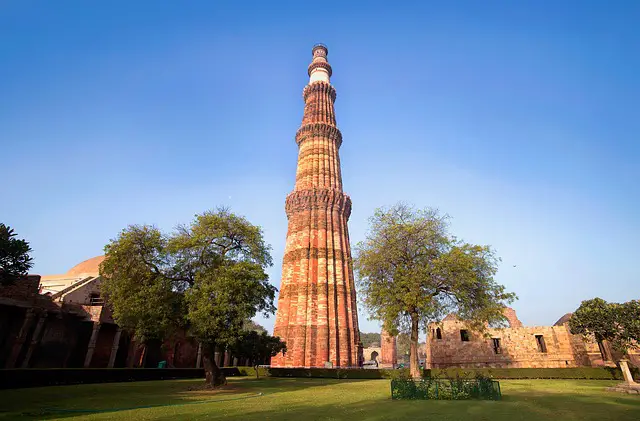
A UNESCO world heritage site and the tallest brick minaret in the world, located in Delhi, India.
What to see or do: Take a walk around the towering structure and admire its intricate architectural details, including its three-dimensional carvings and inscriptions. Climb the 379 steps to the top for a stunning panoramic view of the city.
Don’t miss: The nearby Iron Pillar, which has stood for more than 1,600 years and has not rusted, as well as the intricate geometric patterns of the Quwwat-ul-Islam mosque.
Insider travel tips: Visit early in the morning to avoid crowds and get the best photos. Wear comfortable shoes and be prepared for a bit of a climb if you choose to ascend the tower.
Be mindful of local customs and dress modestly.
3. Red Fort – Delhi
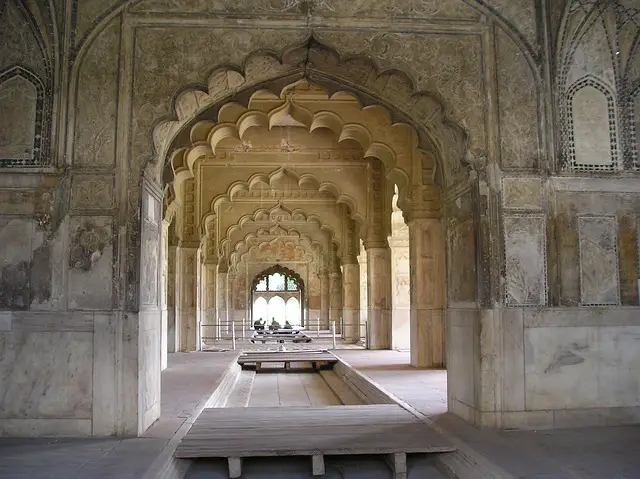
UNESCO World Heritage Site and iconic fortress in Old Delhi.
What to see or do: Explore the beautiful architectural details, visit famous spots such as the Diwan-i-Aam and Diwan-i-Khas, and marvel at the historic artifacts on display.
Don’t miss: The sound and light show that takes place every evening, showcasing the history of the fort through music and visuals.
Insider travel tips: Head to the fort early in the morning to avoid crowds and the heat. Be mindful of pickpockets in the crowded areas around the fort.
Consider hiring a guide to learn about the historical significance and fascinating stories behind the architecture.
4. Gateway of India – Mumbai
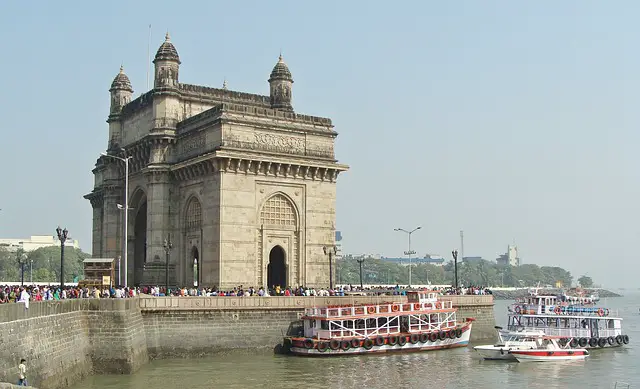
An iconic monument located in Mumbai, India.
What to see or do: Take in the impressive architecture of the Gateway of India, which was built in 1924 to commemorate the visit of King George V and Queen Mary.
It’s a great spot to take in the sea breeze and watch the boats sail by. From here, you can also take a ferry to visit the nearby Elephanta Caves.
Don’t miss: The sunset views from the Gateway of India are absolutely stunning, so make sure to stay until the evening to experience it.
You’ll see the sun dip below the horizon while the sky turns pink and orange.
Insider travel tips: Be prepared for crowds, as this is one of the most popular tourist attractions in Mumbai. If you want a quieter experience, try to visit early in the morning or late at night.
Hiring a local guide can also enhance your experience by providing historical and cultural context for the monument and the surrounding area.
5. Charminar – Hyderabad
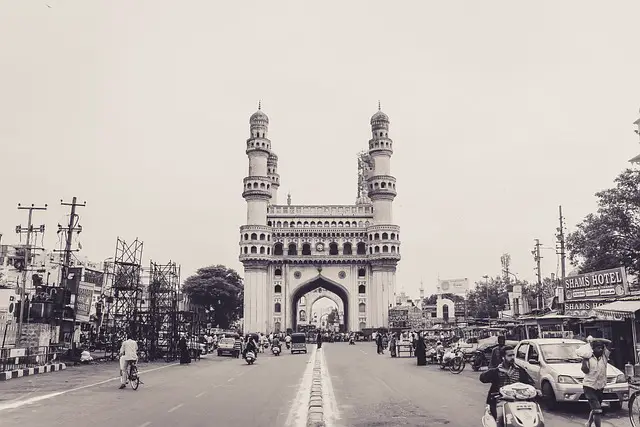
An iconic monument located in the heart of the old city of Hyderabad. Charminar is a historic mosque and a monument which has become a global icon of Hyderabad.
What to see or do: The Charminar offers stunning panoramic views of the city from the top. Visitors can also take a closer look at the intricate stonework, arches and domes that adorn the monument.
In the evening, it is beautifully illuminated creating a mesmerizing view.
Don’t miss: A visit to the bustling marketplaces that surround the Charminar, which offer a wide array of local products and delicacies, including bangles, pearls, clothing and savory treats.
Insider travel tips: – It can be crowded, so it’s best to arrive early in the day to beat the crowds.
6. Hawa Mahal – Jaipur
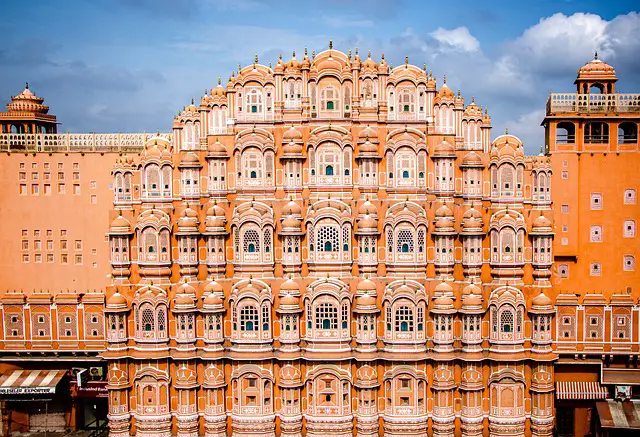
Hawa Mahal is a striking honeycomb-shaped five-storey palace built in 1799, located in the heart of Jaipur.
What to see or do: Admire the intricate and beautiful architecture of the palace from the outside. Go to the top floor for panoramic views of the city.
Don’t miss: The opportunity to take stunning pictures from outside the palace, where the pink sandstone façade glows in the sunlight.
Insider travel tips:
7. Lotus Temple – Delhi
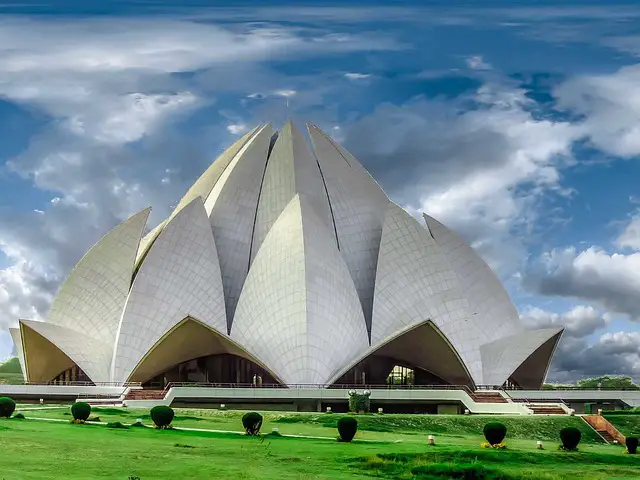
Lotus Temple is a stunning temple made of white marbles in the shape of a lotus flower.
What to see or do: Marvel at the striking lotus-shaped architecture of the temple and witness the tranquil environment it offers. Inside the temple is a prayer hall where visitors can meditate or simply enjoy the peaceful atmosphere.
The temple attracts people from all religions, making it a popular tourist spot.
Don’t miss: Admire the lotus-shaped structure of the temple, which seems to be floating on the tranquil pond. Additionally, you shouldn’t miss the beautiful landscaped gardens surrounding the temple, which are perfect for a peaceful stroll.
Insider travel tips: It’s best to visit early in the morning or late in the afternoon to avoid crowds and enjoy the serene environment.
Dress modestly and remove your shoes before entering the temple. The temple is closed on Mondays.
8. Amer Fort – Jaipur

Amer Fort is a majestic fort palace located in Jaipur, the capital city of the Indian state of Rajasthan.
What to see or do: – Take a guided tour of the fort and learn about its rich history and architecture.
Don’t miss: – Sheesh Mahal, a chamber in the palace known for its shimmering mirror work and intricate glass mosaics.
Insider travel tips: – Visit the fort early in the morning to avoid the crowds and enjoy some peaceful time exploring the palace.
9. India Gate – Delhi
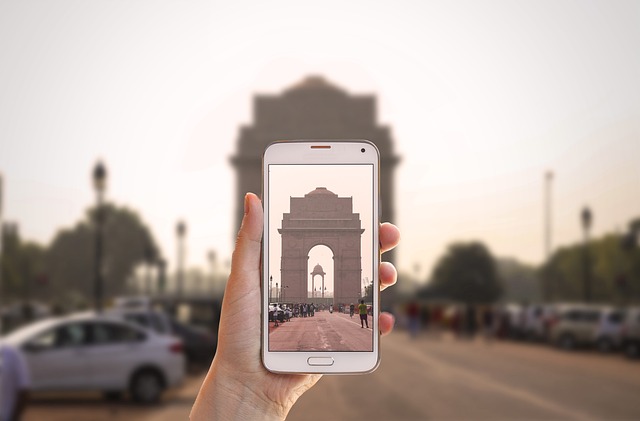
India Gate is a war memorial located in the heart of Delhi, India. It is also known as All India War Memorial.
What to see or do: Visit India Gate during sunset for a beautiful view and to witness the changing of the guard ceremony. Take a stroll around the area and admire the architecture and design of the memorial.
Don’t miss: The names of the Indian soldiers who sacrificed their lives during World War I are inscribed on the walls of the memorial.
Don’t miss paying your respects at the Eternal Flame, also known as Amar Jawan Jyoti.
Insider travel tips: Try some street food from the vendors who set up stalls near India Gate. Make sure to bargain for the best price.
Avoid visiting during the summers as it gets very hot and crowded during that time.
10. Elephanta Caves – Mumbai
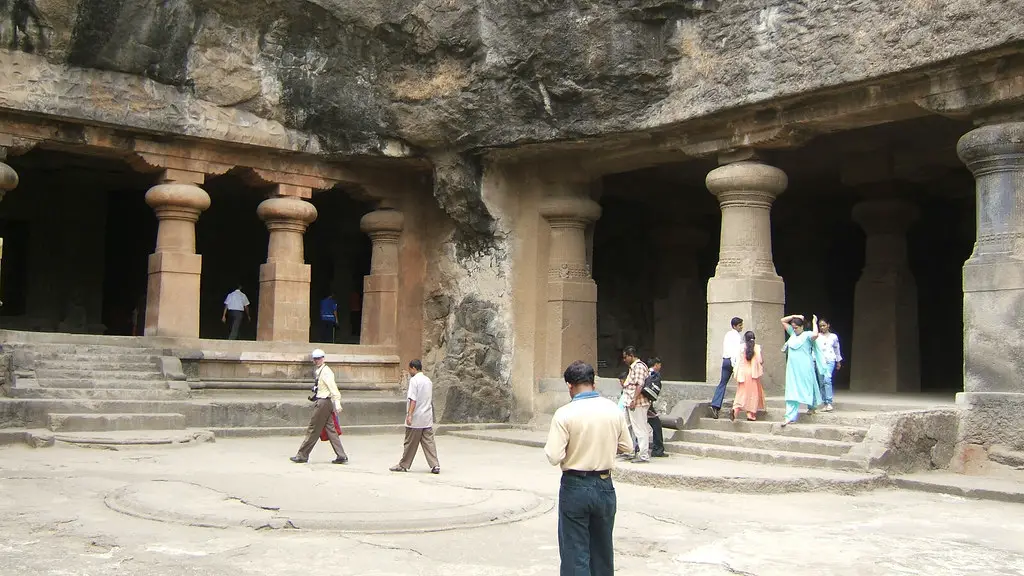
Ancient rock-cut cave temples located on an island off the coast of Mumbai.
What to see or do: Marvel at the intricate carvings and sculptures of Hindu deities that date back to the 5th to 8th centuries AD.
Explore the main cave that features a massive 20-foot statue of Lord Shiva in his three aspects as the creator, preserver, and destroyer.
Don’t miss: The light and sound show that narrates the history and legends associated with the caves in the evening.
Insider travel tips: It’s best to visit during the cooler months of November to February. Avoid weekends and holidays to beat the crowds.
Bring comfortable shoes as there’s a fair amount of walking involved and be prepared to climb a 120-step staircase to reach the caves.
Don’t forget to bring a water bottle and sunscreen.
11. Victoria Memorial – Kolkata
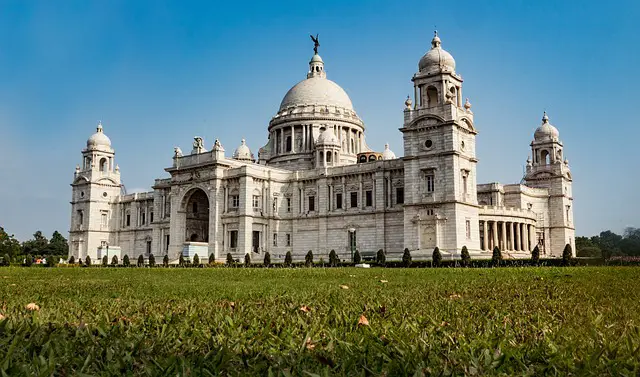
The Victoria Memorial is a large marble building in Kolkata that was built in memory of Queen Victoria. It is now a museum and a popular tourist attraction.
What to see or do:
Don’t miss:
Insider travel tips:
12. Mysore Palace – Mysore
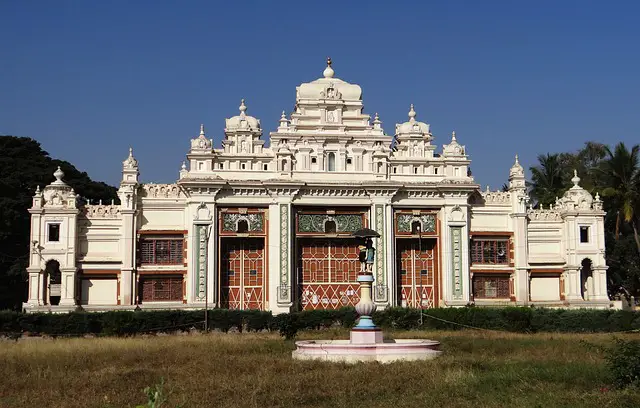
A stunning palace located in the heart of Mysore, India, also known as the Amba Vilas Palace.
What to see or do: Admire the magnificent architecture, intricate carvings, and stunning artworks throughout the palace. Explore the courtyards, royal chambers, and Durbar Hall which is often used for cultural events.
Don’t miss: The vibrant Sound and Light show that takes place every evening. It tells the story of the palace and the royal family who once lived there.
Insider travel tips: Arrive early to avoid crowds and take a guided tour to learn fascinating facts about Mysore Palace. Pick up a souvenir at the palace gift shop selling local handicrafts and artworks.
13. Konark Sun Temple – Odisha
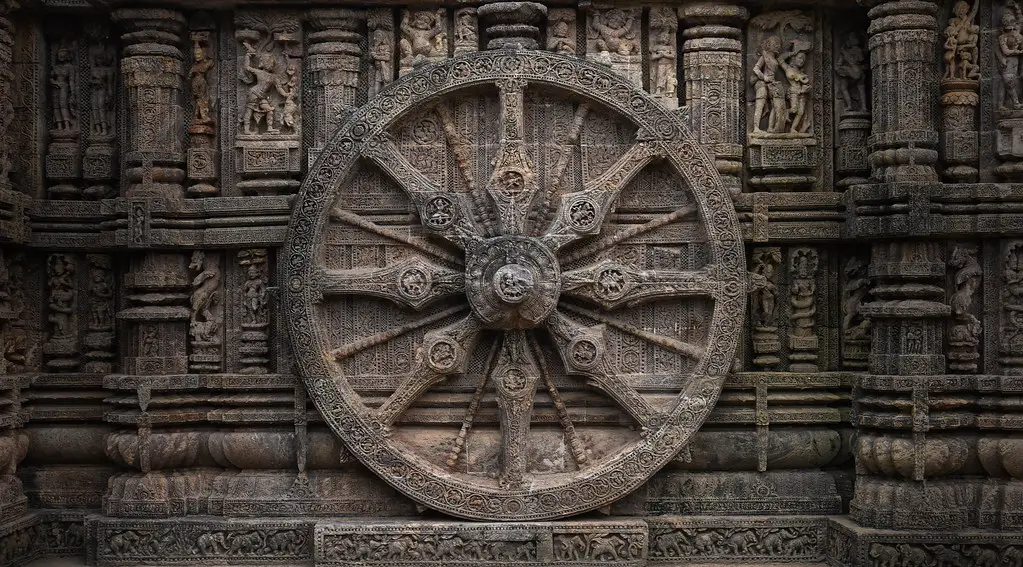
Konark Sun Temple is a UNESCO World Heritage Site located in the coastal town of Konark in the Indian state of Odisha.
What to see or do: The temple is famous for its stunning architecture, which is in the form of a chariot with beautifully carved stone wheels, pillars, and walls.
Visitors can admire the intricate carvings depicting scenes from Hindu mythology, as well as the magnificent sculptures of dancers and musicians.
Don’t miss: The Natya Mandapa or dancing hall is a must-see where musicians and dancers performed in ancient times. Another fascinating feature is the sundial, which was used to calculate time with impressive accuracy.
Insider travel tips: Visitors should arrive early to avoid the crowds and the heat. The temple is best visited during the months of October to March when the weather is cool and pleasant.
Don’t forget to wear comfortable shoes as the temple complex covers a large area. Additionally, carrying a water bottle is recommended as there are limited facilities for refreshments within the temple premises.
14. Khajuraho Temples – Madhya Pradesh
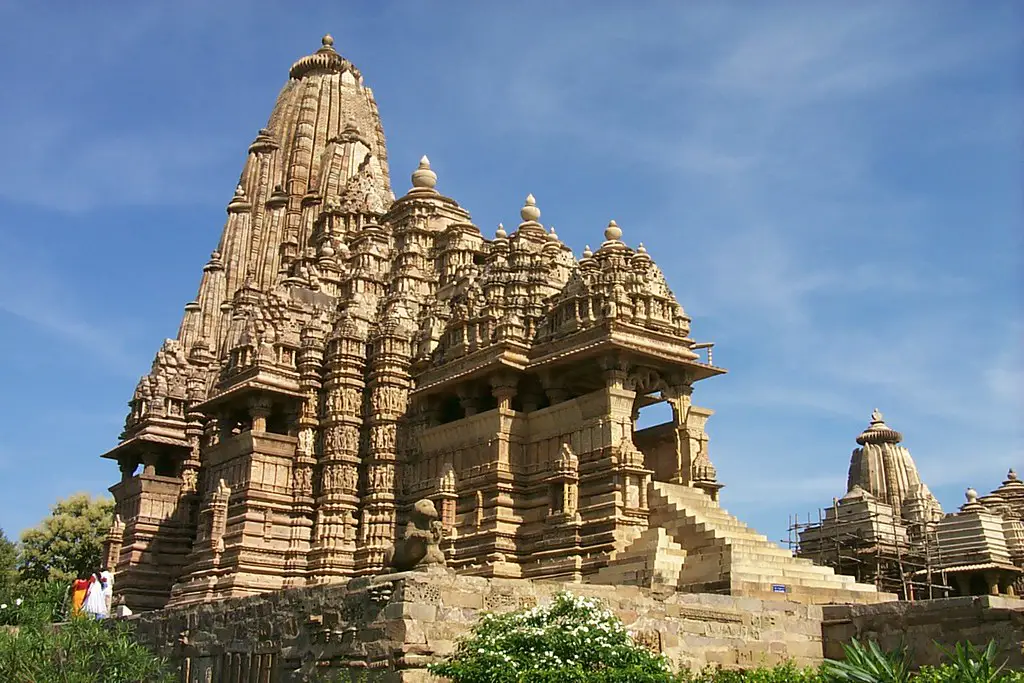
The Khajuraho Temples are a group of Hindu and Jain temples built between 950 and 1050 AD in Madhya Pradesh, India.
They are UNESCO World Heritage Sites and feature exquisite artwork and carvings.
What to see or do: Marvel at the intricate carvings on the temple walls, showcasing various deities, mythological figures and everyday life scenes.
The temples are divided into three groups – Western, Eastern and Southern, each with their own unique architectural style and carvings.
Also, watch the Sound and Light shows held in the evenings to learn the history of temples in a delightful way.
Don’t miss: The Kandariya Mahadeva Temple is the largest and most ornate temple in Khajuraho, with over 800 sculptures.
The Chitragupta Temple dedicated to Surya (the Sun God) is another famous temple known for its architectural style and intricate carvings.
The Jain temples are also fascinating structures with detailed carvings showcasing the Jain pantheon.
Insider travel tips: – Hire a guide to fully appreciate the history and symbolism behind the carvings.
15. Sanchi Stupa – Madhya Pradesh
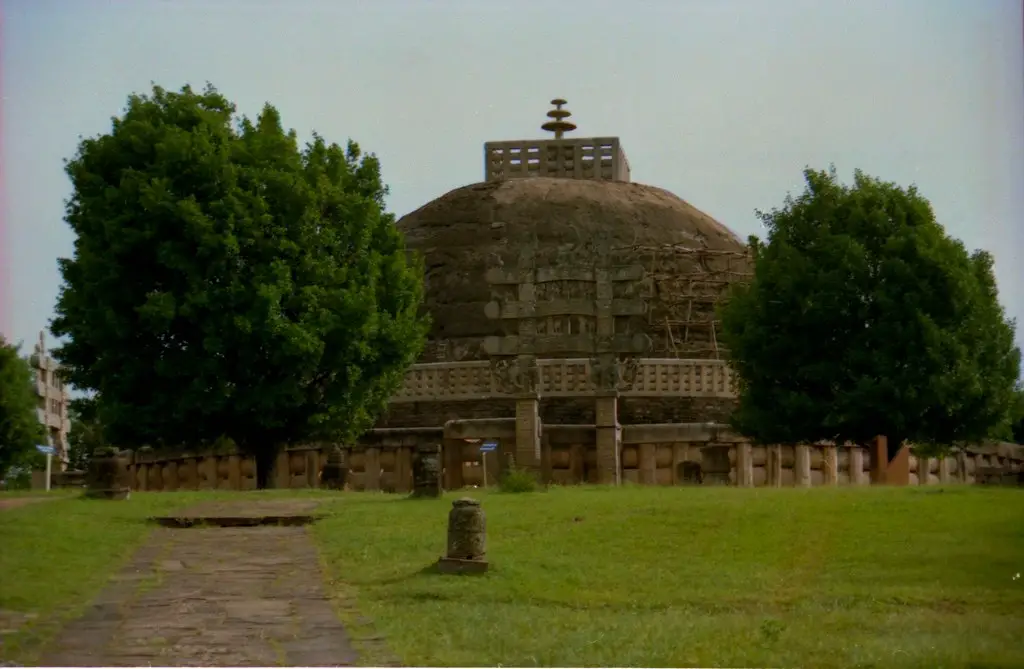
An ancient Buddhist complex located in Sanchi, Madhya Pradesh, India, consisting of several stupas, temples, monasteries and pillars.
What to see or do: Marvel at the magnificent architecture of the Great Stupa, one of the oldest stone structures in India.
Explore the intricately carved gateways called Toranas and admire the exquisite sculptures and carvings that adorn the walls of the temples and monasteries.
Don’t miss: The Ashoka Pillar, which stands tall at over 50 feet and features inscriptions about Ashoka’s reign and his conversion to Buddhism.
Take a walk through the Sanchi Archaeological Museum to learn more about the history and significance of the site.
Insider travel tips: Visit early in the morning or late in the afternoon to avoid crowds and make sure to wear comfortable shoes as there is a lot of walking involved.
Don’t forget to carry a hat, sunscreen and water as the site can get quite warm during the day. If you’re interested in the history and significance of the site, it’s recommended to hire a local guide.
16. Ajanta and Ellora Caves – Maharashtra
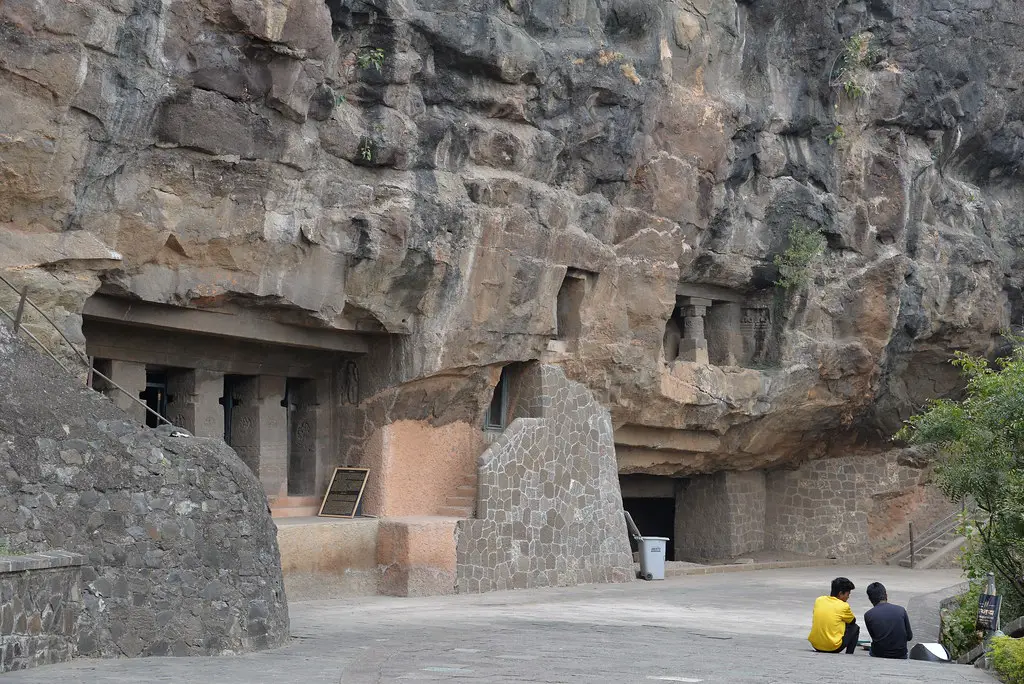
The Ajanta and Ellora Caves are a UNESCO World Heritage Site located in Maharashtra, India.
The 30 Ajanta Caves are rock-cut Buddhist cave monuments dating back to the 2nd century BCE, while the Ellora Caves comprise Hindu, Buddhist and Jain temples carved into a cliff during the 6th to 10th century CE.
What to see or do: Explore the intricate wall murals, sculptures, and intricate embellishments inside the Ajanta Caves, depicting various Buddhist stories like the Jataka tales.
Admire the exceptional stone architecture inside the Ellora Caves, particularly the Kailash Temple, a masterpiece of Indian rock-cut architecture.
Don’t miss: The mesmerizing sculptures, including the reclining Buddha statue, in Cave 26 in Ajanta and the impressive carvings of mythological figures in Ellora’s Cave 32.
Insider travel tips: Visit Ajanta and Ellora during weekdays to avoid the tourist crowds.
17. City Palace – Jaipur
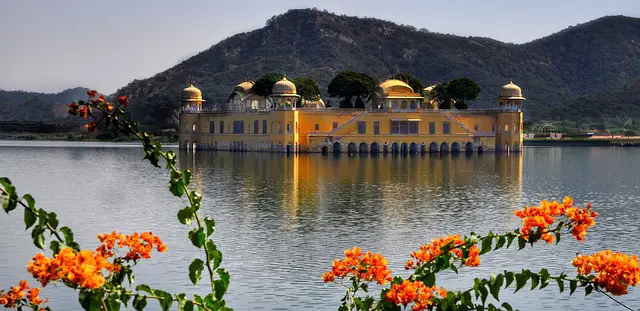
City Palace in Jaipur is a beautiful complex of palaces, gardens, and courtyards that showcases the rich culture and heritage of Rajasthan.
What to see or do: Admire the stunning architecture and intricate design of the palace, including the stunning Peacock Gate and the Diwan-I-Khas hall. Explore the different museums within the complex, showcasing an impressive collection of art, textiles, and weaponry.
Take a stroll through the Mubarak Mahal and the Chandra Mahal, which still house the royal family of Jaipur.
Don’t miss: The Sheesh Mahal, or the Palace of Mirrors, is a must-visit spot within the complex. The walls and ceilings of this room are adorned with mirrors and glasswork, creating a stunning visual spectacle.
Insider travel tips: – Visit the City Palace early in the morning to avoid the crowds and the heat.
18. Fatehpur Sikri – Uttar Pradesh
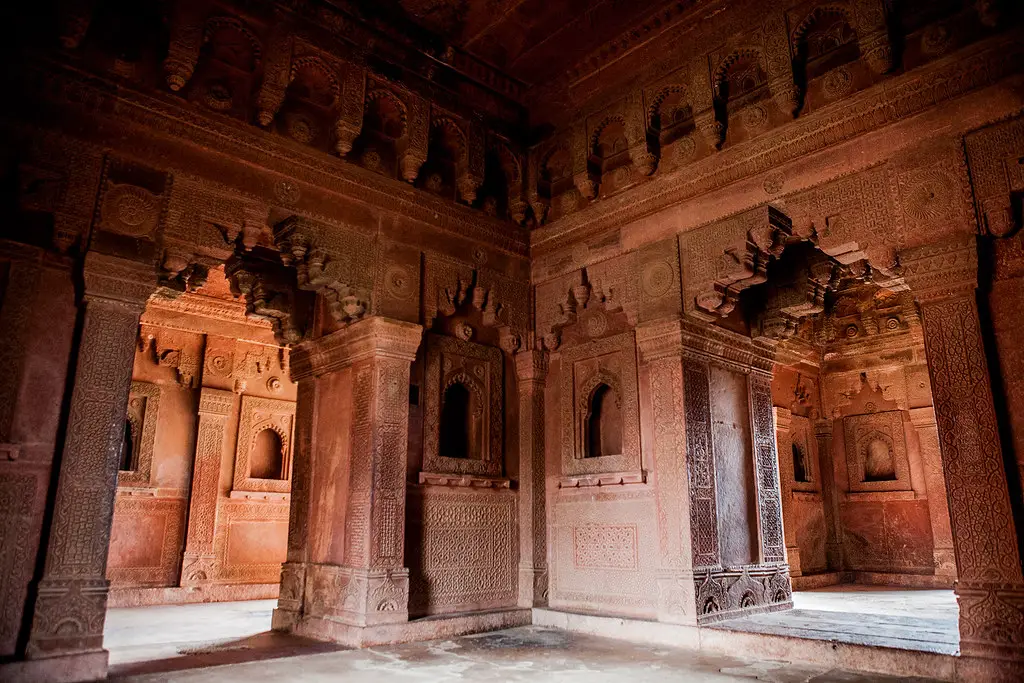
An abandoned fortified city located in Uttar Pradesh, India, built by Mughal Emperor Akbar in the 16th century.
What to see or do: Explore the stunning architecture of the complex, including the Jama Masjid, Panch Mahal, Buland Darwaza, and Diwan-i-Khas. Marvel at the intricate carvings and details on the buildings and walls.
Take a walk around the complex and enjoy the serene ambiance.
Don’t miss: The fascinating history behind the construction and abandonment of Fatehpur Sikri, as well as the intricate craftsmanship and design that is on display throughout the site.
Insider travel tips: Visit during the cooler months of the year (November to February) to avoid the scorching heat. Wear comfortable shoes as there is a lot of walking involved.
Don’t forget to carry water and sunscreen. Plan your visit during the week to avoid crowds on weekends.
19. Salar Jung Museum – Hyderabad
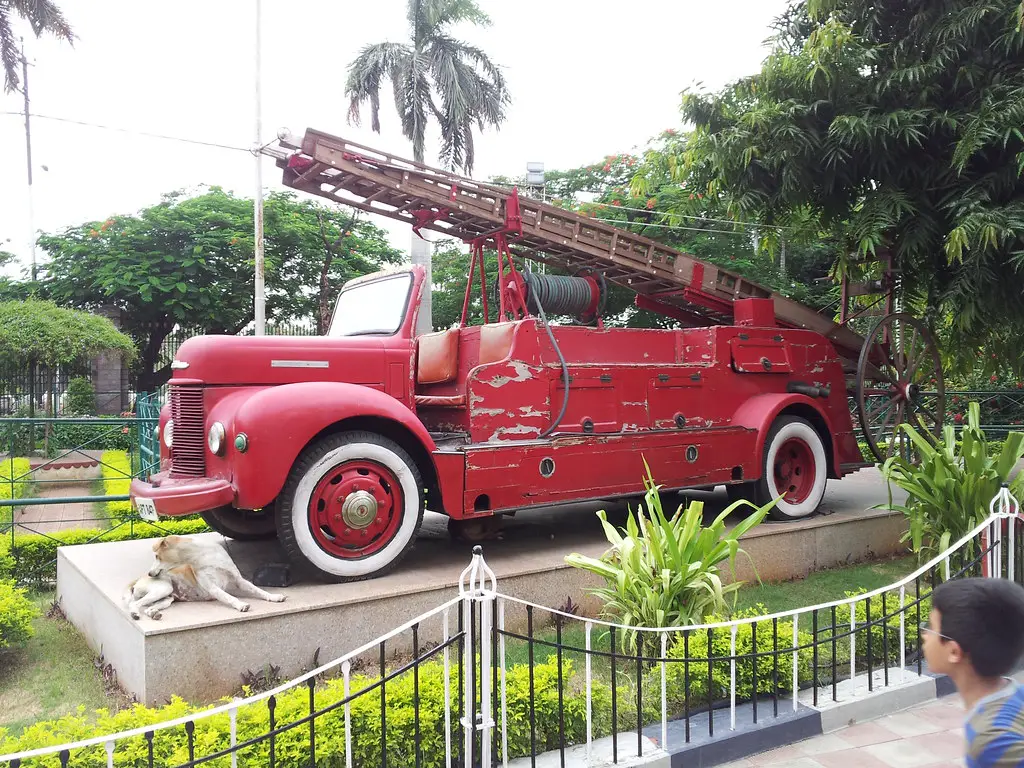
Salar Jung Museum is one of the largest one-man collections of the world, located in Hyderabad, India. It has a collection of over 43,000 art objects and 50,000 books.
What to see or do: The museum boasts an exquisite collection of artifacts from around the world, including paintings, sculptures, textiles, ceramics, and much more. Some of the highlights include a veiled Rebecca, a jade sword, and a mechanical clock.
Visitors can also see various historical manuscripts, calligraphy, and ancient weaponry.
Don’t miss: Don’t miss the famous ivory statue of Mephistopheles and the musical clock tower, which plays a different melody every hour. Also, don’t miss the European paintings and bronze artifacts from the medieval period.
Insider travel tips: The museum is closed on Fridays, so plan accordingly.
20. Jantar Mantar Observatory – Jaipur
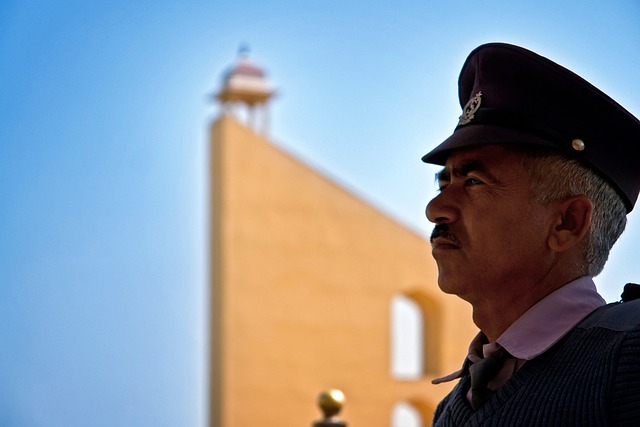
Jantar Mantar is an astronomical observatory built in the early 18th century, located in Jaipur, Rajasthan, India.
What to see or do: Explore the 19 architectural instruments that were designed to measure time, predict eclipses, track celestial bodies, and more with amazing accuracy.
Learn about Indian astronomy and the importance of astrology in Indian culture.
Don’t miss: The Samrat Yantra, the world’s largest sundial, which can measure time to an accuracy of 2 seconds.
The Vrihat Samrat Yantra, which is a 90-foot high sun-dial that casts a shadow that moves up to 4 inches an hour.
Insider travel tips: It’s best to visit in the morning or early afternoon to avoid crowds and the hottest part of the day. Hire a guide as the instruments can be difficult to understand without proper explanation.
Wear comfortable shoes as there is a lot of walking involved.
21. Brihadeeswara Temple – Thanjavur
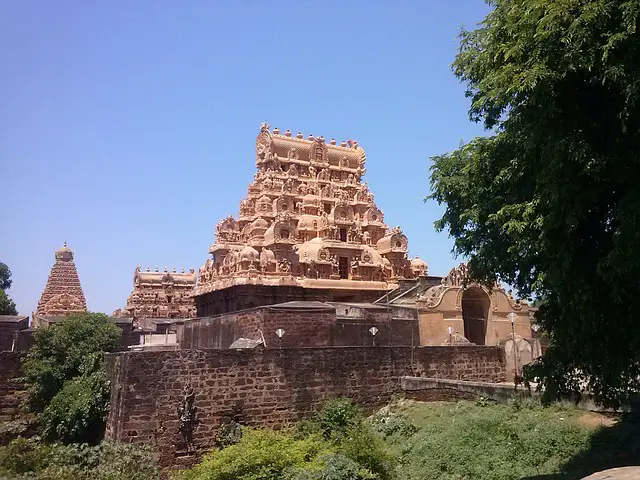
Brihadeeswara Temple, also known as Peruvudaiyar Kovil, is a Hindu temple dedicated to Lord Shiva.
What to see or do: Admire the colossal structure of the temple which was built in the 11th century and is one of the largest temples in South India.
Marvel at the impressive Dravidian architecture and intricate carvings on the walls.
Don’t miss: The giant Nandi statue, made of a single stone, which is located near the entrance of the temple. Witness the daily rituals and ceremonies performed by the priests and immerse yourself in the spiritual ambiance.
Insider travel tips: Visit early in the morning or in the evening to avoid the crowds and experience the serene atmosphere. Wear comfortable footwear as you need to walk barefoot inside the temple.
Follow the dress code which requires visitors to cover their shoulders and wear traditional clothing.
22. Mahabodhi Temple – Bodh Gaya
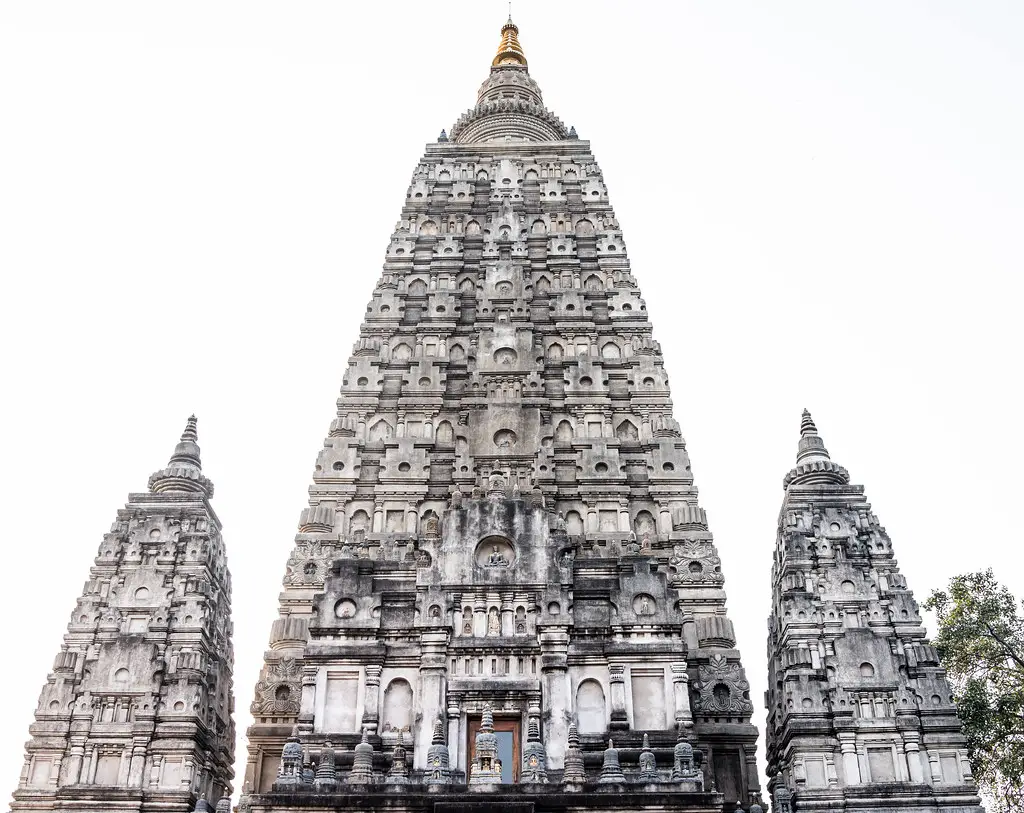
Mahabodhi Temple is a UNESCO World Heritage Site located in Bodh Gaya, India. It is a revered site for Buddhists as it is believed to be the place where Gautama Buddha attained enlightenment.
What to see or do: Visitors can explore the Mahabodhi Temple Complex, which includes several temples, shrines, and meditation sites. The main temple, Mahabodhi Mahavihara, is a stunning example of ancient Indian architecture and features a 50-meter-high pyramid-shaped tower.
Visitors can also see the famous Bodhi tree, under which Lord Buddha is said to have attained enlightenment.
Don’t miss: The Mahabodhi Temple Complex is home to many other important Buddhist sites such as the Animeshlocha Stupa, Ratnagarh, and much more.
Take a stroll in the beautiful premises of the temple complex.
Insider travel tips: – Respect the dress code and remove your shoes while entering the main temple area.
23. Lake Palace – Udaipur
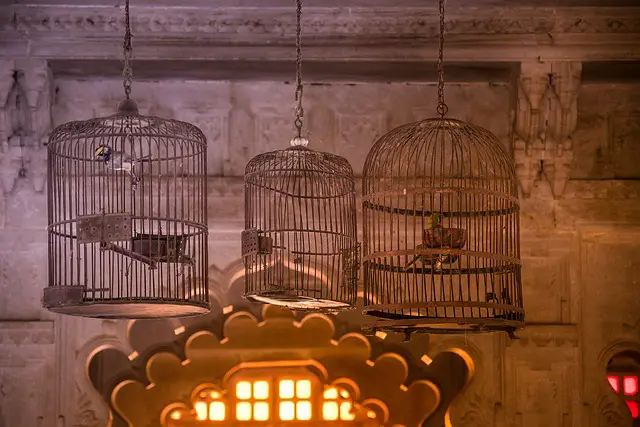
Lake Palace is a luxurious hotel that sits on an island in Lake Pichola in Udaipur, Rajasthan.
What to see or do: – Take a stroll around the palace’s beautiful gardens and courtyards.
Don’t miss: – The stunning architecture and design of the palace, which features intricate stone carvings, colorful mosaics, and gorgeous marble work.
Insider travel tips: – While the Lake Palace is a highly popular and luxurious hotel, it’s worth noting that rooms can be quite pricey.
Consider visiting for a meal or drink at the hotel’s restaurant or bar if you’re traveling on a budget.
24. Chhatrapati Shivaji Terminus – Mumbai
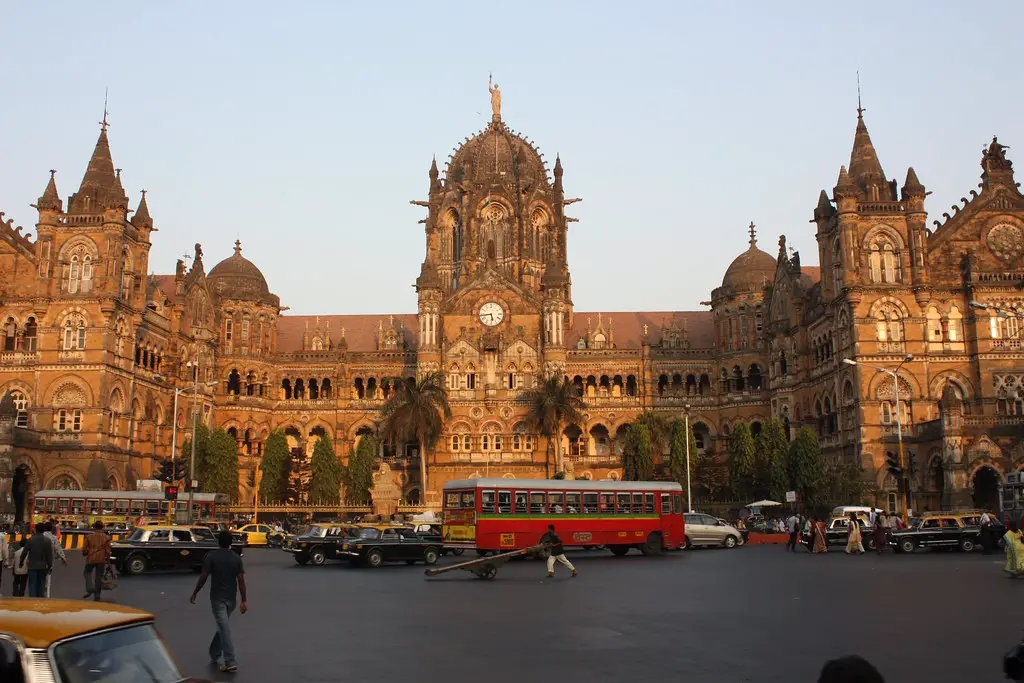
Chhatrapati Shivaji Terminus (CST) is a historic railway station located in the heart of Mumbai, India. It serves as the headquarters of the Central Railway of India and is a UNESCO World Heritage Site.
What to see or do: Take a walk around the magnificent building and admire the Victorian Gothic architecture.
Marvel at the grandeur of the structure, which has been beautifully preserved and stands as a symbol of Mumbai’s rich history.
Board a train to travel across India or simply people-watch at this bustling station.
Don’t miss: The Heritage Gallery inside CST houses a collection of photographs, artifacts, and documents that offer a fascinating glimpse into the station’s past.
The building’s imposing facade is particularly impressive at night when it is bathed in floodlights.
Insider travel tips: Watch out for pickpockets and make sure to keep your belongings safe while at the station.
The best time to visit is during the early morning hours when the crowd is thin, and the station is relatively quiet.
If you’re interested in photography, this is a great place to capture some stunning shots.
25. Amer Palace and Fort – Jaipur
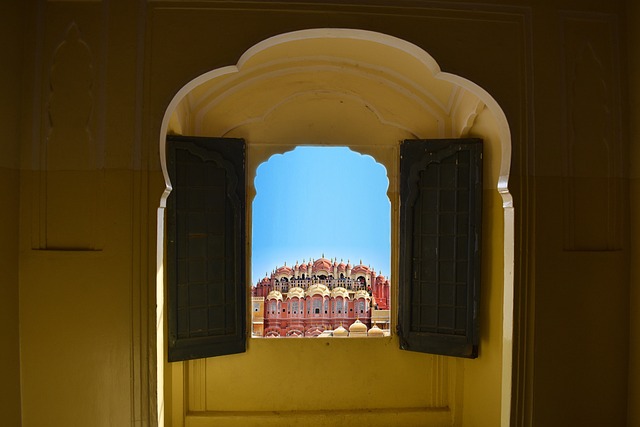
Amer Palace and Fort is a stunning complex located in Jaipur, Rajasthan.
What to see or do: Visitors can explore the intricate architecture and design of the palace, which includes beautiful courtyards, gardens, and buildings such as the Sheesh Mahal (Mirror Palace) and Sukh Niwas.
The fort also offers stunning panoramic views of the surrounding areas.
Don’t miss: The Sound and Light Show at Amer Fort is a spectacular experience, showcasing the history and culture of the palace and fort through a beautiful light display and narration.
Insider travel tips: – Visit early in the morning to avoid large crowds and hot weather.
26. Jaisalmer Fort – Rajasthan
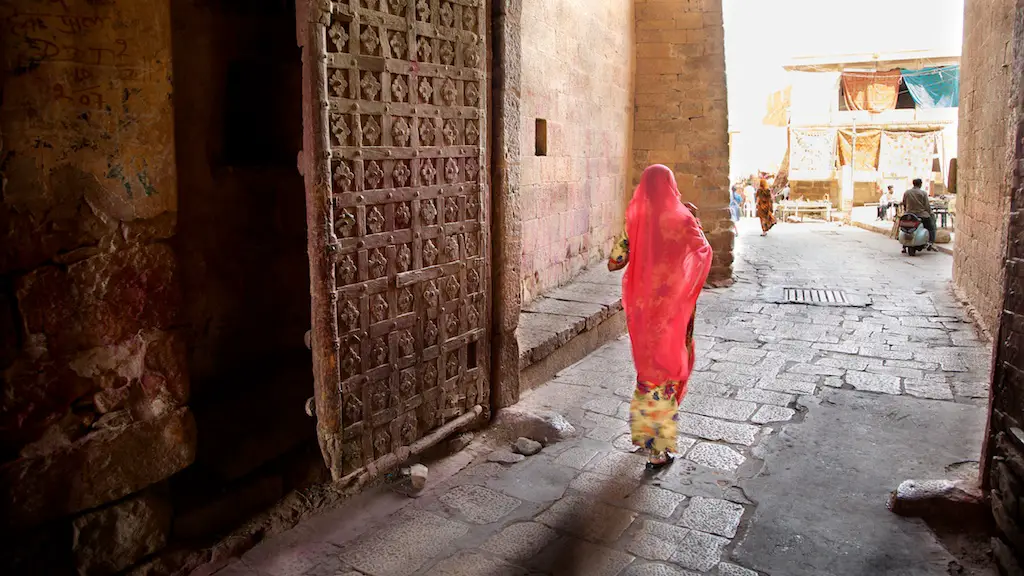
Jaisalmer Fort is one of the few living forts in the world and a UNESCO World Heritage Site located in Jaisalmer, Rajasthan.
It is an architectural marvel that was built in the 12th century and is considered one of India’s most beautiful forts.
What to see or do: Explore the narrow alleys of the fort and marvel at the architecture of its palaces, temples, and havelis. Visit the Jain temples located inside the fort, known for their intricate carvings and stunning architecture.
Take a guided tour to know more about the history of the fort and its significance.
Don’t miss: Catch the spectacular sunset from the fort as it turns into golden honey color and highlighting its beautiful details. Attend the famous Desert Festival held in February every year, which features camel races, folk dances, and other cultural events.
Insider travel tips: Wear comfortable shoes as you’ll be walking a lot.
27. Mehrangarh Fort – Jodhpur
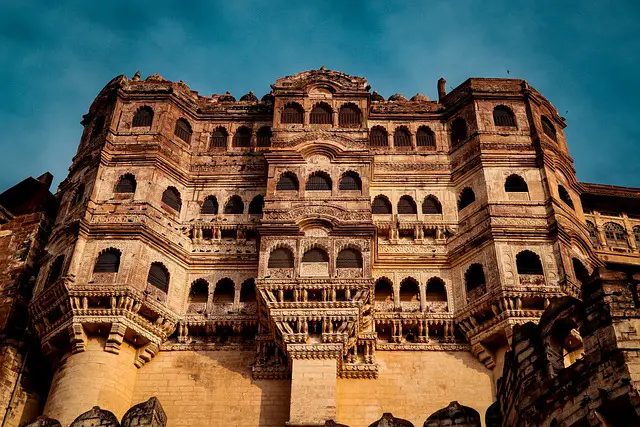
Mehrangarh Fort is a massive and imposing architectural marvel situated in the city of Jodhpur in Rajasthan, India.
What to see or do: Visit the seven gates that lead up to the fort and marvel at the intricate carvings on the walls. Explore the palaces that provide a glimpse into the opulent lifestyles of the Rajput kings.
Visit the rich museum that displays artifacts from the Mughal period and displays arms, costumes, paintings, and decorated period rooms.
Don’t miss: Make sure to visit the Sheesha Mahal, Jhanki Mahal, and the Moti Mahal. A visit to the Chamunda Mataji temple located within the fort premises is a must-visit.
The panoramic view of Jodhpur from the ramparts is breathtaking.
Insider travel tips: Plan to spend at least half a day exploring the fort and soaking up its history.
28. Belur Math – Kolkata
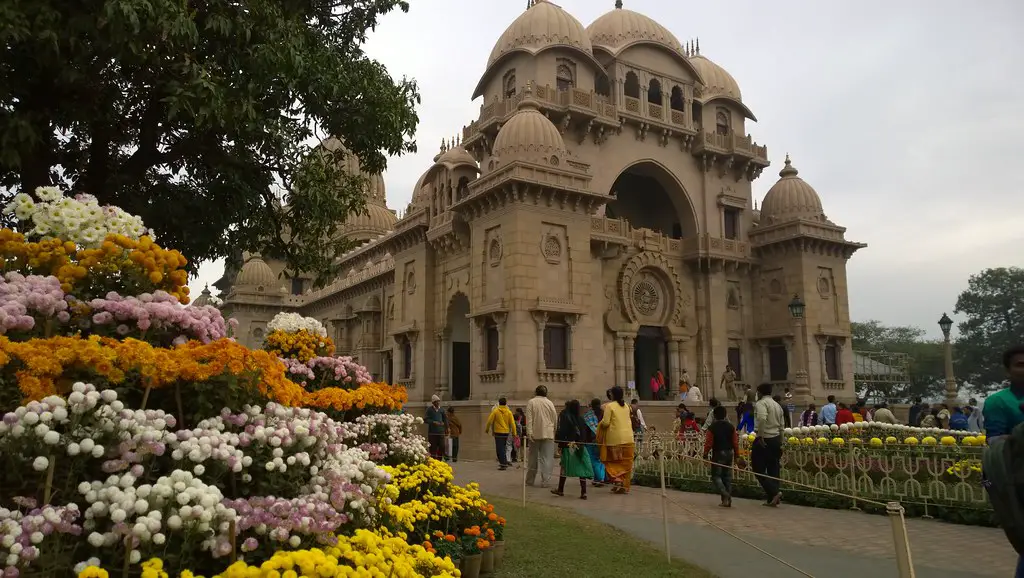
Belur Math is a large complex of Hindu temples and ashrams located in Kolkata, India.
What to see or do: Visitors can explore the picturesque grounds and gardens, visit the different temples and shrines, observe the daily prayers and rituals, attend a meditation or yoga session, and learn about the life and teachings of Swami Vivekananda.
Don’t miss: The main temple, known as the Temple of Sri Ramakrishna, is a must-see with its stunning architecture and peaceful atmosphere.
The adjacent shrine of Swami Vivekananda is also a popular spot, as it contains his relics and a museum showcasing his life and work.
Insider travel tips: Visitors should dress modestly and remove their shoes before entering the temples. Photography is not allowed inside the main temple, but it is allowed in other areas of the complex.
Guided tours are also available and highly recommended, as they provide a more in-depth understanding of the culture and history of Belur Math.